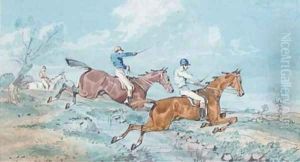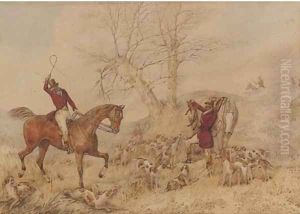Henry Samuel Jun Alken Paintings
Henry Thomas Alken, born in 1785 in London, was a prolific English painter and engraver known primarily for his hunting, coaching, and sporting scenes. Coming from a family with a strong artistic lineage, his father, Samuel Alken, was also an artist, which provided Henry with an early exposure to the world of art. Despite the expectations set by his family's artistic background, Henry carved out a unique niche for himself, focusing largely on the depiction of English sports and countryside life, which resonated with the British gentry and middle classes of the time.
Alken began his artistic career at a relatively young age, initially training under his father and then furthering his education in the art schools of London. By the early 19th century, he had established himself as a skilled painter and engraver. His work was characterized by a keen observation of life and movement, capturing the dynamism of horse racing, fox hunting, and other country sports with a blend of accuracy and whimsy. Alken's ability to depict these scenes with both humor and detail made his work popular among those who participated in and appreciated these quintessentially British pastimes.
Throughout his career, Alken produced a vast number of paintings, illustrations, and engravings. He was adept at both watercolors and oil paintings, but his engraved works, often published in book form, brought him the most recognition. Notable publications include 'The National Sports of Great Britain' (1821), and a series of prints titled 'Humorous Specimens of Riding 1821'. These works not only showcase his artistic talent but also serve as valuable historical documents that offer insight into early 19th-century British culture and leisure activities.
Alken's influence extended beyond his lifetime, with his sons also becoming artists. Despite facing financial difficulties in later years, his work continued to be sought after and appreciated by collectors and enthusiasts of equestrian and sporting art. Alken passed away in 1851, leaving behind a legacy that has continued to be celebrated for its contribution to British sporting art. His works are held in high regard and can be found in major art collections, museums, and galleries across the United Kingdom and beyond.

